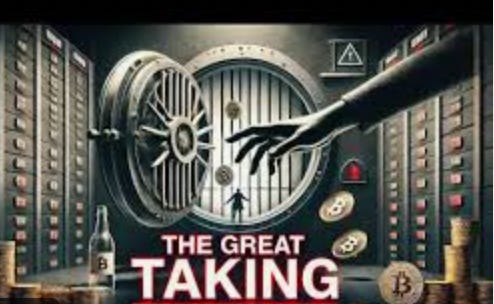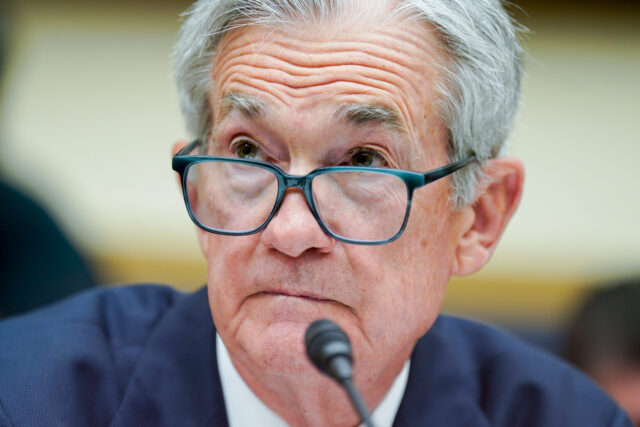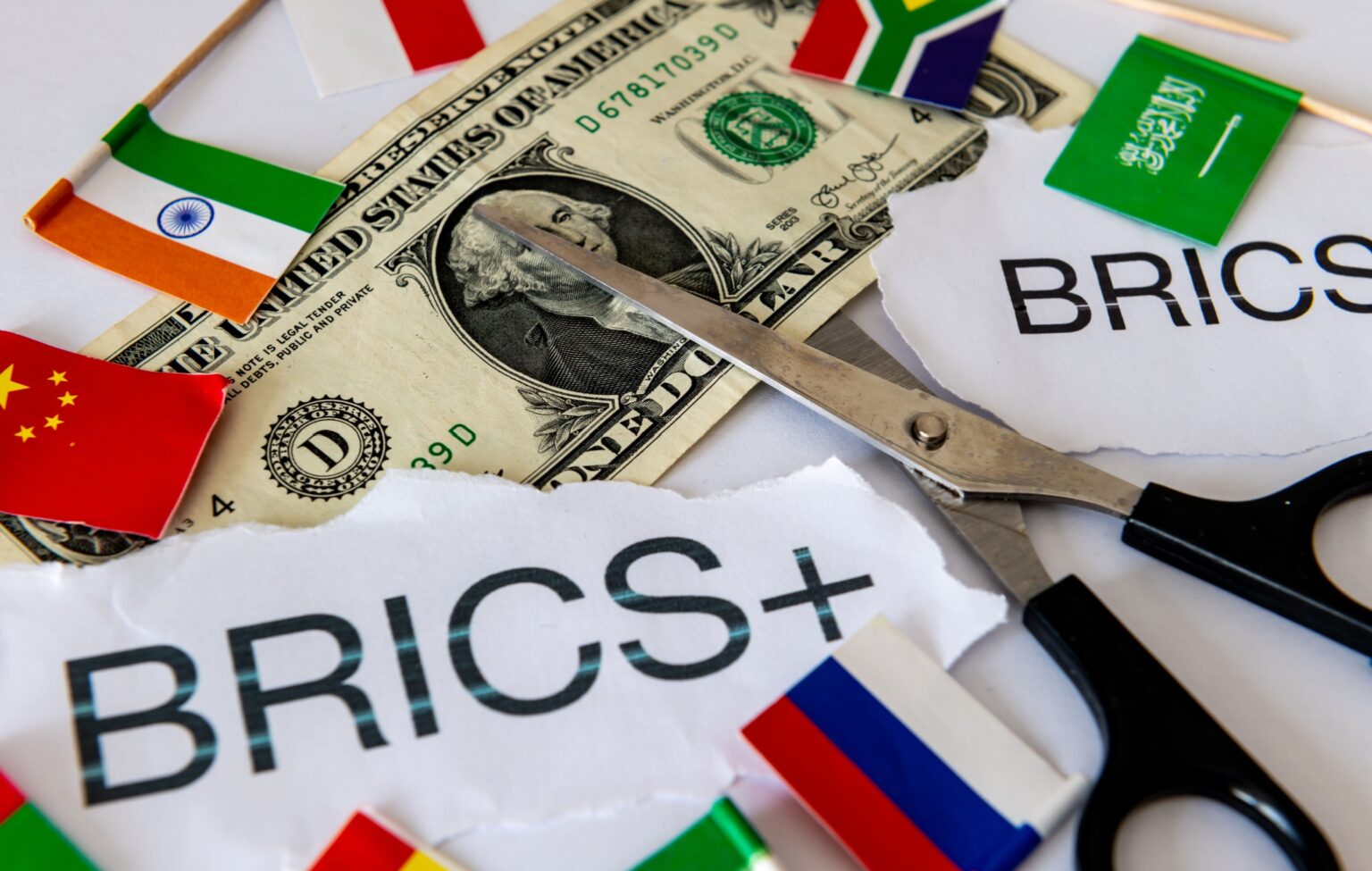from Liberty and Finance
The 2025 Dollar Collapse: Heading For the Biggest Decline Since 1986
by Steven Longenecker
Stansberry Research

Halfway through 2025, the U.S. dollar is looking downright sickly…
The once-mighty greenback has slumped so much this year that it will likely post its worst first-half performance since 1986. For context, that was right after the Plaza Accord – when the dollar was deliberately pushed off a cliff by global policymakers.
Fast forward to today, and the dollar’s slide is raising the specter of something we haven’t seen in decades: significant capital flight from the United States.
And that could spell trouble for your financial security.
Let’s start with the numbers…
Can a Systemic Crisis Even Be Avoided at This Point?
Michael Gayed, CFA, outlines the current economic landscape by tying credit cycles and market signals to systemic risks.
by Dr. Chris Martenson
Chris Martenson’s Peak Prosperity
 In this Finance U podcast, I had the pleasure of speaking with Michael Gayed, CFA, who has a significant following on X, with over 760,000 followers, and runs the insightful Lead Lag Report on Substack. We delved into the current economic landscape, focusing particularly on the credit cycle and the potential for a serious if not systemic credit event.
In this Finance U podcast, I had the pleasure of speaking with Michael Gayed, CFA, who has a significant following on X, with over 760,000 followers, and runs the insightful Lead Lag Report on Substack. We delved into the current economic landscape, focusing particularly on the credit cycle and the potential for a serious if not systemic credit event.
We discussed:
— The disconnect between the bond market’s perception of default risk and the performance of small-cap stocks, which seem to be signaling distress. He’s been vocal about expecting a significant market dislocation due to this divergence, suggesting that while credit spreads remain tight, small caps are indicating a looming credit strain.
I’m Far More Concerned About the Deficit Than World War III
by James Hickman
Schiff Sovereign

I can understand why so many people are worried about World War 3 breaking out. It’s a completely rational concern. I just don’t happen to share it.
Why? Because regardless of the debate over whether the US strikes against Iran’s nuclear facilities were a good idea, or a reckless risk of another expensive foreign entanglement, one thing is indisputable: America reminded the world of its immense military capabilities.
There’s not a single adversary nation that wants to risk armed conflict with the US after watching those stealth bombers obliterate their targets.
And the proof is already here: Iran’s foreign minister flew to Moscow seeking military support from Russia… and Putin offered absolutely nothing except for strong words.
This is why I’m more convinced than ever that World War 3 is NOT going to break out over this conflict: no other country wants F-35s or B-2 stealth bombers in their airspace, let alone the 75th Ranger Regiment and ‘Delta Force’ special operators.
Central Banks Eye Gold, Euro and Yuan as Dollar Dominance Wanes
by Yoruk Bahceli and Dhara Ranasinghe
Reuters.com
 LONDON, June 24 (Reuters) – The custodians of trillions of dollars of global central bank reserves are eyeing a move away from the greenback into gold, the euro and China’s yuan as the splintering of world trade and geopolitical upheaval spark a rethink of financial flows.
LONDON, June 24 (Reuters) – The custodians of trillions of dollars of global central bank reserves are eyeing a move away from the greenback into gold, the euro and China’s yuan as the splintering of world trade and geopolitical upheaval spark a rethink of financial flows.
According to a report, opens new tab by the Official Monetary and Financial Institutions Forum (OMFIF) due to be published later on Tuesday, one in three central banks managing a combined $5 trillion plan to increase exposure to gold over the next one-to-two years after stripping out those planning to decrease, the highest in at least five years.
The Somewhat Bedraggled U.S. Dollar Against the Euro, Yen, Canadian Dollar, Dollar Indices, and Soft Currencies Like the Indian Rupee
by Wolf Richter
Wolf Street
 No longer the cleanest dirty shirt.
No longer the cleanest dirty shirt.
The somewhat bedraggled US dollar lost more ground against the euro today. It now takes 1.16 USD to buy 1.00 EUR, putting the dollar at the lowest level against the euro since November 2021.
In early January, after the euro had fallen against the USD for three months, there was talk that the euro would fall below parity with the dollar. That didn’t happen. After the euro dropped to $1.02, it bounced off and then began to soar.
Over the longer term, as we’ll see in a moment, the EUR/USD exchange rate just moved back into the middle of the long-term range.
“The Great Taking”: Vast Systemic Risk in the Financial System?
Filmmaker James Patrick explains how banks can use YOUR securities to collateralize THEIR derivates contracts, thereby creating massive systemic risk.
by John Leake, Courageous Discourse
LewRockwell.com
 In recent years I have often wondered if the constant drama—often deliberately produced and amplified by corrupt and inept governments—is a means of distracting our attention from the fact that those who work in the financial industry have become astronomically wealthy since the Financial Crisis of 2009, while the middle and working classes have struggled to keep up with the rising cost of living.
In recent years I have often wondered if the constant drama—often deliberately produced and amplified by corrupt and inept governments—is a means of distracting our attention from the fact that those who work in the financial industry have become astronomically wealthy since the Financial Crisis of 2009, while the middle and working classes have struggled to keep up with the rising cost of living.
Especially suspicious in this regard have been the endless ravings about Racism and Russia that have been broadcast for the last several years.
Talking about Racists and Russians behind every bush was an easy way to distract attention from the fact that the Obama administration didn’t prosecute a single major Wall Street executive for fraud, even as solid evidence of vast Wall Street fraud emerged during the first years of his administration.
Powell Pushes Back On Trump, Says Tariff Uncertainty Justifies Holding Rates Steady
by John Carney
Breitbart.com
 Federal Reserve Chair Jerome Powell told Congress on Tuesday that the central bank is not ready to resume cutting interest rates, citing lingering uncertainty over how new tariffs will affect consumer prices. Powell said the strength of the economy gives the Fed room to wait for more data before adjusting its policy stance.
Federal Reserve Chair Jerome Powell told Congress on Tuesday that the central bank is not ready to resume cutting interest rates, citing lingering uncertainty over how new tariffs will affect consumer prices. Powell said the strength of the economy gives the Fed room to wait for more data before adjusting its policy stance.
“For the time being, we are well positioned to wait to learn more about the likely course of the economy before considering any adjustments,” Powell said in testimony before the House Financial Services Committee.
The remarks come as inflation has declined from last year’s highs and job growth has slowed, leading some Fed officials to push for rate cuts as early as July. But Powell signaled that the central bank is in no hurry, pointing to the possibility that import duties imposed by President Trump in April could still filter through to prices in the months ahead.
Dollar’s Decline Meets Rising Dedollarization: The Threat Comes From Within
The Bloomberg Dollar Index has fallen nearly 8.5 percent, its steepest drop since the 1980s. Elsewhere, incremental signs point to emerging alternatives.
by Peter C. Earle
The Daily Economy
 The recent weakness in the US dollar has reignited the debate over the durability of the dollar’s dominance in global finance. Over the first half of the year, the Bloomberg Dollar Index has fallen nearly 8.5 percent, marking one of the sharpest declines since the mid-1980s. Yet while this drawdown has fueled widespread commentary about de-dollarization, it is important to distinguish between dollar weakness — a familiar, cyclical phenomenon — and the far more consequential and complex issue of de-dollarization, which concerns the dollar’s standing as the world’s primary reserve currency and medium of international exchange.
The recent weakness in the US dollar has reignited the debate over the durability of the dollar’s dominance in global finance. Over the first half of the year, the Bloomberg Dollar Index has fallen nearly 8.5 percent, marking one of the sharpest declines since the mid-1980s. Yet while this drawdown has fueled widespread commentary about de-dollarization, it is important to distinguish between dollar weakness — a familiar, cyclical phenomenon — and the far more consequential and complex issue of de-dollarization, which concerns the dollar’s standing as the world’s primary reserve currency and medium of international exchange.
Genuine Risk For a U.S. Bond Collapse
by Michael Pento
Kitco
 The US debt-to-GDP ratio is currently at 123% and is projected to reach 140% by 2029. Annual deficits now equal 6.4% of GDP, and the Congressional Budget Office forecasts that the deficit will rise to 9% of GDP, or $2.7 trillion, by 2035. The interest payments on US debt alone account for approximately 3% of the country’s GDP. Even if the primary deficit were eliminated, the debt-to-GDP ratio would not fall unless the underlying economic growth exceeded 3%. However, this is highly unlikely, as both the labor force and productivity are shrinking, with productivity down 1.5% in the first quarter. Achieving consistent 3% growth is therefore impossible.
The US debt-to-GDP ratio is currently at 123% and is projected to reach 140% by 2029. Annual deficits now equal 6.4% of GDP, and the Congressional Budget Office forecasts that the deficit will rise to 9% of GDP, or $2.7 trillion, by 2035. The interest payments on US debt alone account for approximately 3% of the country’s GDP. Even if the primary deficit were eliminated, the debt-to-GDP ratio would not fall unless the underlying economic growth exceeded 3%. However, this is highly unlikely, as both the labor force and productivity are shrinking, with productivity down 1.5% in the first quarter. Achieving consistent 3% growth is therefore impossible.
This year alone, the deficit will add an amount equivalent to 40% of all federal revenue to the national debt. For fiscal year 2025, the deficit already stands at $1.36 trillion, with four months remaining in the year. This figure is 14% higher than last year, and debt financing is expected to run above $1.2 trillion for the fiscal year, totaling $776 billion over the first eight months. Our debt now equals 740% of federal revenue. By 2035, the national debt is expected to reach $67 trillion. It took the United States 250 years to accumulate the first $37 trillion of national debt, and we are now on track to add another $30 trillion in the coming decade.
Oil Price Shock From U.S. Strikes On Iran Could Stoke Stagflation Risks
by Martin Baccardax
Barron’s

However with Iran threatening retaliation for the attacks and vowing to escalate its conflict with Israel, investors are bracing for the impact of a major oil price shock over the coming weeks.
A spike in crude prices that lasts into the summer months and beyond could stoke inflation pressures, hammer U.S. GDP growth forecasts and corner the Federal Reserve into a “wait-and-see” stance on monetary policy that could delay interest-rate cuts until the end of the year.
“At this moment, global attention is centered squarely on Iran and the nature of its response to recent developments,” said Kristian Kerr, head of macro strategy at LPL Financial. “The situation remains highly fluid, and much hinges on whether Tehran opts for a restrained reaction or a more aggressive course of action.”
Money Supply Rose for the Ninth Month in April as the Fed Again Leans Dovish
by Ryan McMaken
Mises.org
 Money-supply growth rose year over year in April, marking the ninth month of growth in a row. As of April, the money supply appears to be continuing into a period of solid monetary growth coming out of a period of historically large swings in monetary trends from early 2020 to mid-2024. Although some critics of Jerome Powell and the Fed have claimed that the Fed is implementing excessively tight monetary policy, the money supply has grown by more than $600 billion since mid-2023.
Money-supply growth rose year over year in April, marking the ninth month of growth in a row. As of April, the money supply appears to be continuing into a period of solid monetary growth coming out of a period of historically large swings in monetary trends from early 2020 to mid-2024. Although some critics of Jerome Powell and the Fed have claimed that the Fed is implementing excessively tight monetary policy, the money supply has grown by more than $600 billion since mid-2023.
In April, year-over-year growth in the money supply was at 2.2 percent. That’s up from March’s year-over-year increase of 1.4 percent. April’s increase is also a big change from April 2024 when the year-over-year growth rate was negative 0.4 percent.
